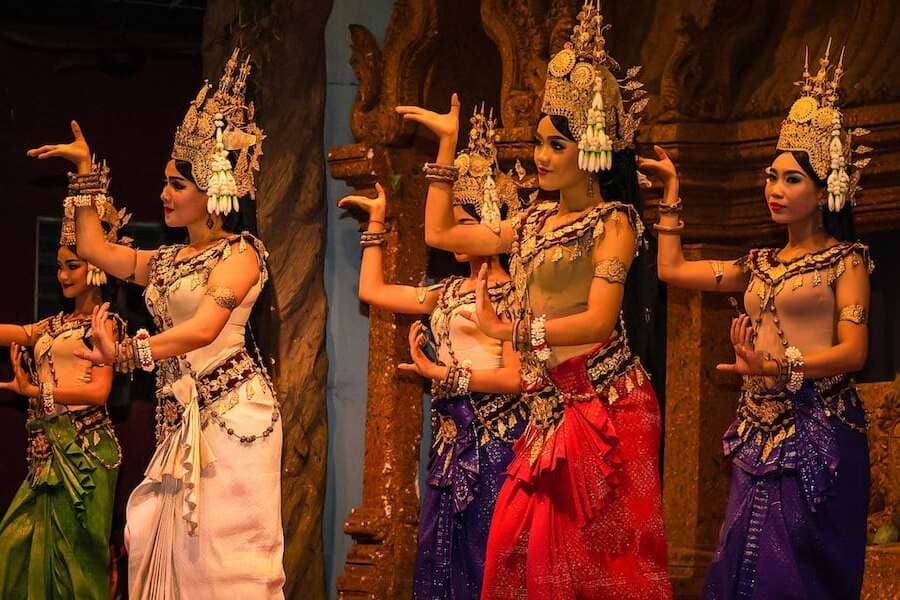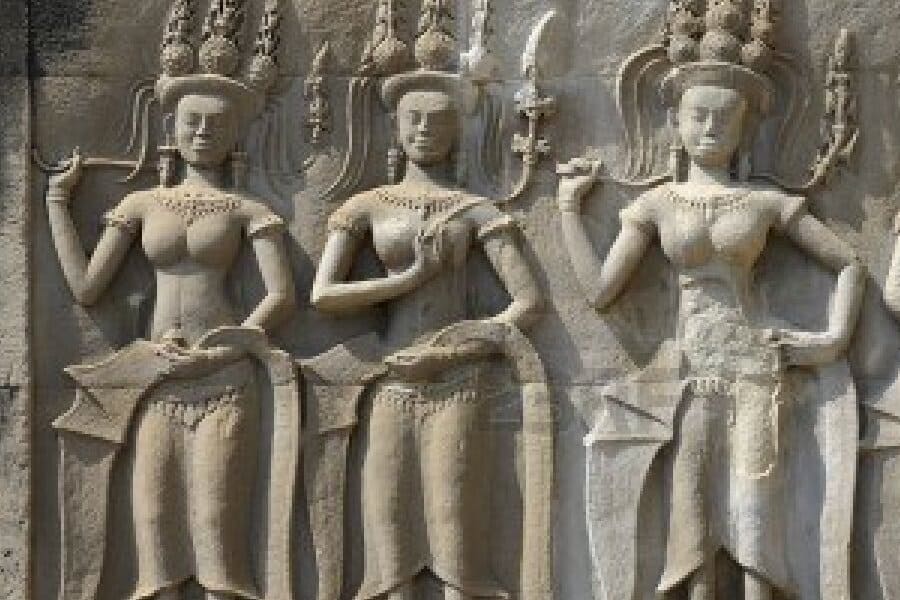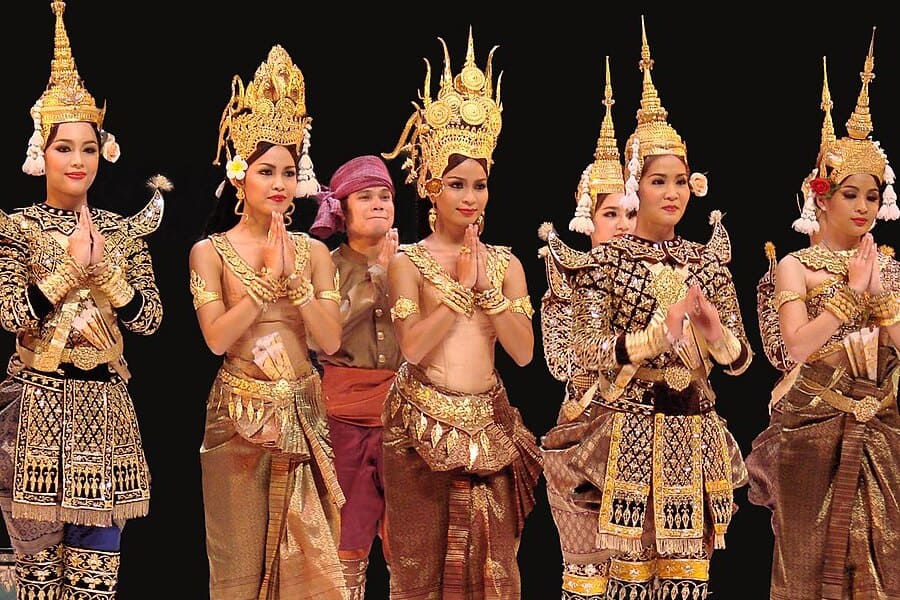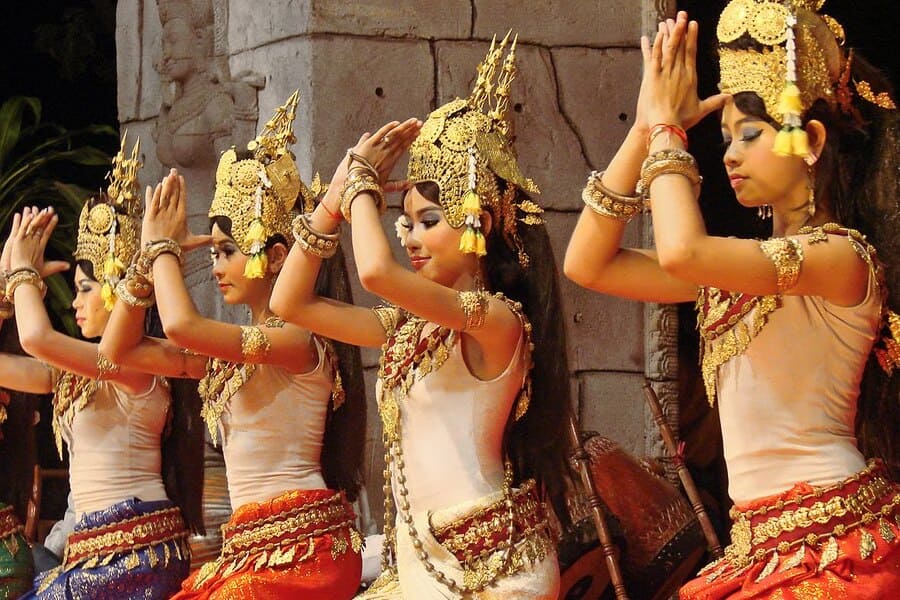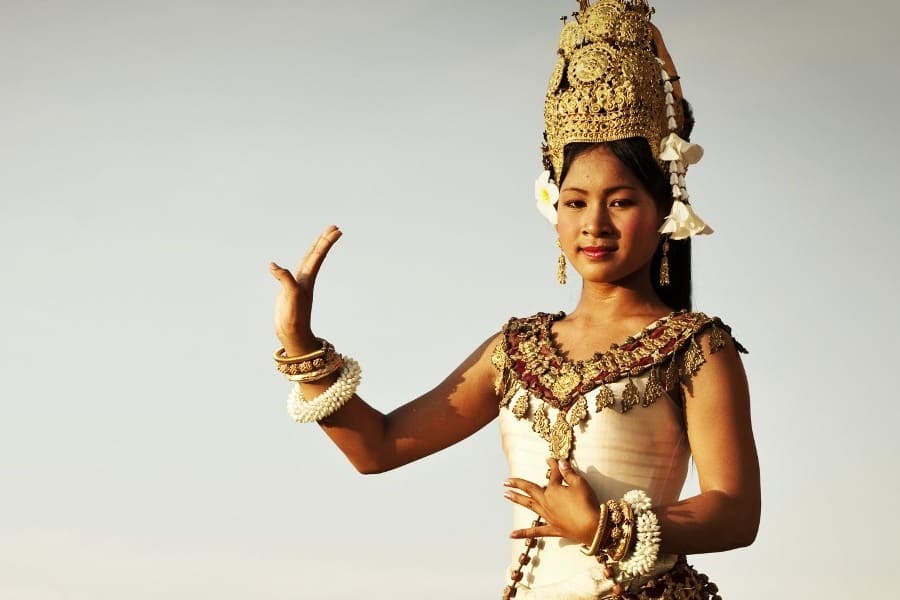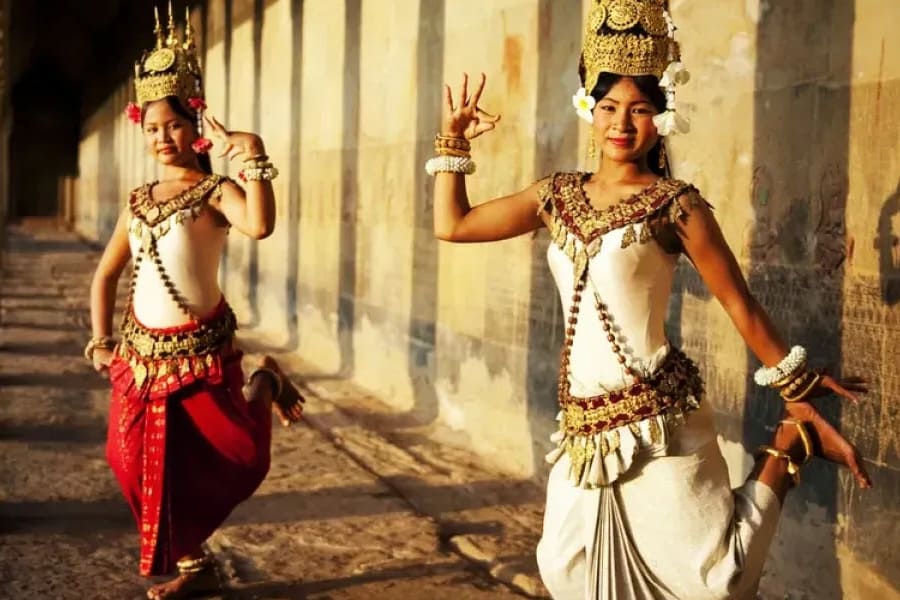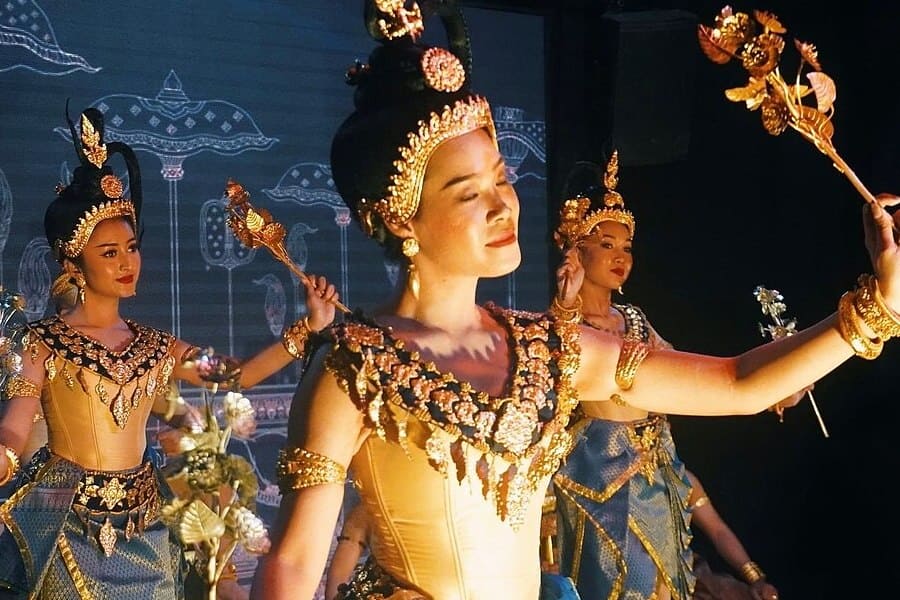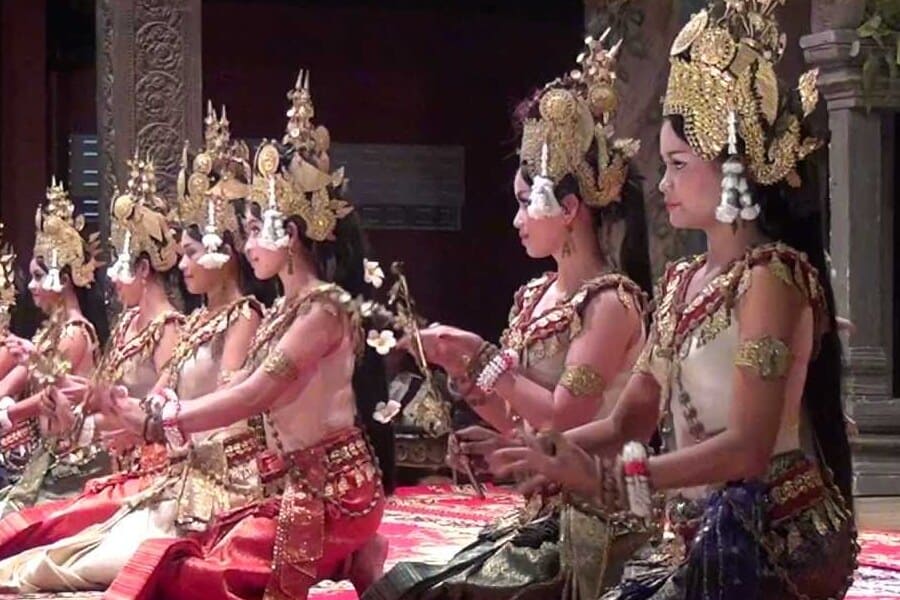Experience the captivating Apsara Dance Performance, an essential highlight of any Cambodia tour package. This traditional Khmer dance, renowned for its graceful movements and intricate costumes, offers a glimpse into Cambodia’s vibrant cultural heritage and artistic traditions.
Contents
An overview of Apsara Dance
The history and origins of Apsara Dance
The Apsara Dance finds its origins in Hindu mythology, where Apsaras are celestial nymphs known for their beauty, grace, and artistic talents. These divine beings are believed to inhabit the heavenly courts of gods and entertain them with their enchanting dances.
During the height of the Khmer Empire (9th to 15th centuries), the Apsara Dance flourished as an integral part of royal court rituals and religious ceremonies. Apsara carvings adorn the walls of numerous temples, including Angkor Wat and Angkor Thom, serving as a testament to the dance’s cultural significance.
Apsara Dance performances were often sponsored by Khmer kings and nobles as a means of celebrating auspicious occasions, such as royal coronations, temple dedications, and religious festivals. These performances were highly regarded as expressions of divine beauty and spiritual devotion.
Over time, the Apsara Dance evolved into a refined form of classical dance, characterized by its graceful movements, intricate hand gestures (mudras), and elaborate costumes. The dance repertoire expanded to include various mythological narratives and storytelling elements.
During the colonial era and subsequent periods of political turmoil, the Apsara Dance faced challenges to its survival. However, efforts to preserve and revive Khmer cultural traditions, including dance, gained momentum in the 20th century, leading to a resurgence of interest in the Apsara Dance.
Today, the Apsara Dance continues to thrive as a cherished symbol of Cambodian identity and cultural pride. Dance schools, cultural institutions, and government initiatives are dedicated to preserving and promoting the Apsara Dance tradition, ensuring its continuity for future generations.
Symbolism and Meaning of Apsara Dance
In Cambodia, the Apsara Dance holds deep cultural significance and is rich in symbolism, representing various aspects of Khmer identity and spirituality. Here’s an exploration of the symbolism and meaning of the Apsara Dance in Cambodia:
- Cultural Heritage and Identity: The Apsara Dance is a symbol of Cambodia’s cultural heritage and national identity, rooted in the country’s ancient traditions and artistic legacy. Through its graceful movements and intricate choreography, the dance celebrates the unique cultural heritage of the Khmer people and their enduring connection to their ancestral roots.
- Divine Femininity and Grace: In Cambodian culture, Apsaras embody the ideals of divine femininity, grace, and beauty. The dancers’ elegant gestures and flowing movements reflect these qualities, evoking a sense of serenity, poise, and refinement. Apsara dancers are revered for their ability to convey the timeless essence of feminine grace and allure.
- Spiritual Symbolism and Mythology: The Apsara Dance is steeped in Hindu mythology and spiritual symbolism, drawing inspiration from ancient epics such as the Ramayana and the Mahabharata. Apsaras are believed to be celestial beings who inhabit the heavenly realms and serve as messengers, dancers, and companions to the gods. Through the Apsara Dance, performers evoke the divine presence of these celestial nymphs, embodying their ethereal beauty and otherworldly grace.
- Artistic Expression and Creativity: The Apsara Dance serves as a platform for artistic expression and creativity, allowing dancers to convey a wide range of emotions, narratives, and themes through movement and gesture. From tales of love and heroism to expressions of joy and devotion, the dance offers a canvas for performers to explore the depths of human experience and the mysteries of the cosmos.
- Cultural Preservation and Revival: In modern-day Cambodia, efforts to preserve and promote the Apsara Dance reflect a broader commitment to safeguarding the country’s cultural heritage and artistic traditions. Dance schools, cultural institutions, and government initiatives are dedicated to training new generations of Apsara dancers and ensuring the continued vitality of this ancient art form.
- Tourism and Cultural Diplomacy: The Apsara Dance plays a pivotal role in Cambodia’s tourism industry, attracting visitors from around the world who are eager to experience the country’s vibrant cultural heritage. Apsara Dance performances are often featured in cultural shows, dinner performances, and traditional Khmer restaurants, offering tourists a captivating glimpse into Cambodia’s rich artistic traditions.
Costumes and Choreography of the Apsara Dance
Costumes of the Apsara Dance
- Apsara dancers wear elaborate costumes that are inspired by traditional Khmer attire and ancient Hindu mythology. These costumes are adorned with intricate designs, embellishments, and vibrant colors, reflecting the celestial beauty and grace of the Apsaras.
- The costume typically consists of a sampot, a traditional Khmer wrap-around skirt, which is worn with a matching top or blouse. The sampot is often made of silk or other luxurious fabrics and may feature intricate patterns or motifs.
- Apsara dancers also wear ornate jewelry, including necklaces, bracelets, earrings, and anklets, which add to the regal elegance of their attire. These accessories are often embellished with gemstones, pearls, and gold accents, symbolizing the celestial splendor of the Apsaras.
Headdresses and Accessories of the Apsara Dance
- One of the most striking elements of the Apsara Dance costume is the elaborate headdress worn by the dancers. The headdress typically features intricate designs, including floral motifs, beading, and sculpted elements, which frame the dancer’s face and accentuate their movements.
- Apsara dancers may also wear decorative hair ornaments, such as tiaras, hairpins, and hair combs, which are adorned with flowers, feathers, or jewels. These accessories add a touch of elegance and sophistication to the dancer’s appearance.
Choreography of the Apsara Dance
- The choreography of the Apsara Dance is characterized by fluid, graceful movements that evoke the ethereal beauty and celestial grace of the Apsaras. Dancers perform a series of intricate hand gestures, known as mudras, which convey various emotions, symbols, and narratives.
- The choreography often incorporates elements of classical Khmer dance, including stylized poses, flowing arm movements, and delicate footwork. Dancers move with precision and poise, creating a sense of harmony and balance that reflects the divine nature of the Apsaras.
- Apsara dancers may perform solo or in groups, with synchronized movements that convey a sense of unity and cohesion. The choreography may also include storytelling elements, with dancers interpreting mythological narratives and symbolic themes through their movements.
Performance Venues and Shows of the Apsara Dance
In Cambodia, visitors have the opportunity to experience the captivating beauty of the Apsara Dance at various venues and shows across the country. Here’s where you can enjoy authentic Apsara Dance performances accompanied by live music and traditional Khmer cuisine:
Traditional Khmer Restaurants
- Many traditional Khmer restaurants in tourist areas, especially in Siem Reap and Phnom Penh, offer Apsara Dance performances as part of their dining experience. These restaurants often feature nightly shows where guests can enjoy delicious Khmer cuisine while watching skilled Apsara dancers perform.
- Examples of reputable traditional Khmer restaurants known for their Apsara Dance performances include Koulen Restaurant, Angkor Village Apsara Theatre, and Temple Balcony Restaurant in Siem Reap, as well as Tonle Sap Restaurant and Romdeng in Phnom Penh.
Cultural Centers
- Cultural centers and performance venues in major cities like Phnom Penh and Siem Reap frequently host Apsara Dance shows for both local residents and tourists. These venues provide a platform for professional dance troupes to showcase their talent and preserve the traditions of Khmer dance.
- Notable cultural centers that offer Apsara Dance performances include the National Museum of Cambodia and Chaktomuk Theatre in Phnom Penh, as well as the Cambodia Cultural Village and Wat Bo Temple in Siem Reap.
Hotel Dinner Shows
- Many luxury hotels and resorts in Cambodia organize dinner shows featuring Apsara Dance performances as part of their entertainment offerings for guests. These hotel dinner shows typically include a buffet or set menu of Khmer cuisine, accompanied by live music and dance performances.
- Reputable hotels known for their Apsara Dance dinner shows include Raffles Hotel Le Royal and Sofitel Phnom Penh Phokeethra in Phnom Penh, as well as Sofitel Angkor Phokeethra Golf & Spa Resort and Victoria Angkor Resort & Spa in Siem Reap.
Visitor Experience and Recommendations to attend an Apsara Dance performance
For visitors interested in attending an Apsara Dance performance in Cambodia, here are some tips and recommendations to enhance your experience:
- Book Tickets in Advance: To ensure availability and secure your spot, it’s advisable to book tickets for the Apsara Dance performance in advance, especially during peak tourist seasons. Many venues offer online booking options or allow reservations through hotels and tour operators.
- Arrive Early: Arriving early before the start time of the performance allows you to find good seats and settle in comfortably. Aim to arrive at least 15-30 minutes before the scheduled showtime to avoid any last-minute rush.
- Respect Cultural Etiquette: Show respect for the cultural significance of the Apsara Dance by observing appropriate behavior during the performance. Avoid talking loudly or using mobile phones during the show, as this can disrupt the performers and fellow audience members.
- Dress Appropriately: While there is no strict dress code for attending an Apsara Dance performance, it’s recommended to dress modestly and comfortably. Opt for lightweight, breathable clothing and comfortable footwear, as some venues may have outdoor seating or limited air conditioning.
- Engage with the Performance: Immerse yourself in the beauty and artistry of the Apsara Dance by paying attention to the performers and appreciating their skill and dedication. Observe the intricate choreography, graceful movements, and expressive storytelling that characterize this traditional Khmer dance form.
- Show Appreciation: Show your appreciation for the performers by applauding and acknowledging their efforts at the end of the performance. Consider leaving a tip or making a donation to support the local artists and cultural institutions that preserve and promote the Apsara Dance tradition.

